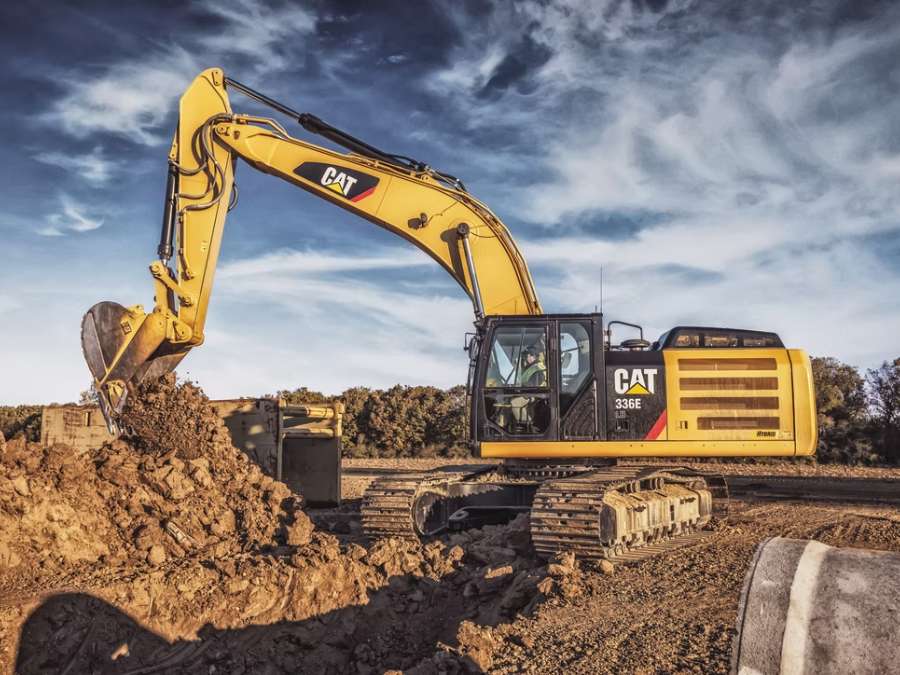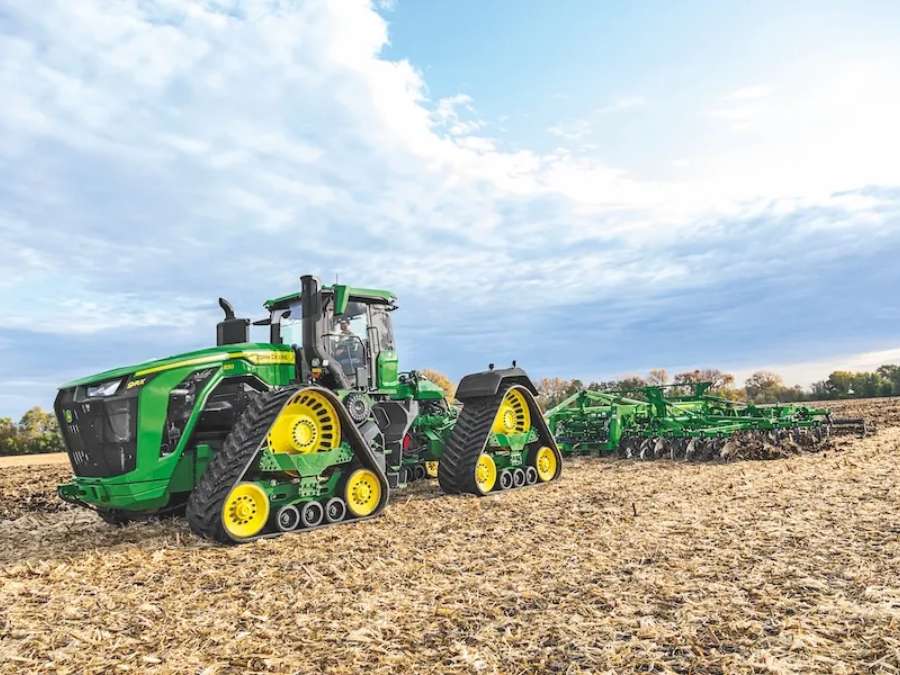Caterpillar vs John Deere: A Detailed Comparison

George Yang | Founder at EPO
Hi, I'm George Yang, here to share my expertise in excavator parts with you.
Table of Contents
Which brand is the right fit for your next heavy equipment investment, Caterpillar or John Deere? Both are industry leaders, but which of them truly stands out?
As an expert in analyzing the construction and machinery industry, I’ve seen firsthand how these brands compete. My insights will help you make a well-informed decision based on your specific needs.
Caterpillar is known for its well built, durable machines, while John Deere stands out for its advanced technology and user-friendly controls.
In this guide, we’ll dive into the strengths and weaknesses of both brands. We will also compare their performance, and learn which brand is better suited for different types of jobs.
So let’s get started!
1. Caterpillar Overview
Caterpillar has been a global leader in construction and heavy equipment for nearly a century, known for producing reliable machinery. Their extensive product line includes everything from excavators to wheel loaders, all designed to tackle the toughest jobs. Explore more about Caterpillar’s key offerings below:
Products Offered
- Bulldozers: Their bulldozers are strong machines used for pushing large quantities of materials. They are ideal for mining operations, where powerful machines are necessary for moving heavy materials.
- Wheel Loaders: Wheel loaders are versatile and used to load materials like gravel, sand, or dirt. These loaders make construction and landscaping projects more efficient by quickly moving and loading materials.
- Motor Graders: Their motor graders are used to create smooth surfaces, especially for road construction. These machines help level surfaces best for building roads and preparing land for development.
- Excavators: Caterpillar excavators are known for their power and durability. These machines are commonly used in construction and mining due to their reliable performance and versatility.
At EPO, we offer a wide range of high-quality parts specifically for Caterpillar excavators, helping to keep them in peak condition. Here are some of the parts available for various Caterpillar excavator models:
| Parts | Models |
| Air Compressor, Alternator, Backhoe Parts, Bucket Teeth, Catalytic Converter, Cylinder Head, ECM (Engine Control Module), Exhaust Manifold, Fan Belt, Final Drive, Fuel Filter, Fuel Injector, Fuel Pressure Regulator, Fuel Pump, Hydraulic Control Valve, Hydraulic Cylinder, Hydraulic Hose, Hydraulic Oil Filter, Hydraulic Pump, Injector Solenoid, Injection Pump, Jake Brake Solenoid, Lift Cylinder, Oil Cooler, Oil Filter, Radiator, Rocker Arm Assembly Starter, Steering Pump, Swing Motor, Thermostat, Tilt Cylinder, Track Adjuster, Turbocharger, Water Pump | 420, 259D, 424B, 330, 320, 336, 308, 305, 303.5, 312, 315, 320D, 320D2, 330B, 330D, 340, 3406, 3406E, 3508, 3512, 3600, 416, 420D, 420E, 432, 963, 992G, 988H, 854K, 797F, 777, 140, 140G, 140H, 140M, 120M2, 120M, D2, D5, D6, D8, D10, D11, D14, 930, 938, 950, 977, 299D, 299D3, 215, 225, 235, 262C, 275, 277, 299, 304, 307, 311, 315BL, 320B, 320C, 330C, 330CL, 336D, 395 |
Industries Served
- Construction: Their machines are key in the construction industry. They are widely used in road building, infrastructure projects, and heavy lifting.
- Mining: Caterpillar is essential in mining operations. Its equipment supports both surface and underground mining, improving efficiency and safety.
- Agriculture: This brand helps increase farm productivity. Their tractors and loaders make handling large agricultural fields easier.
- Forestry: They provide machinery for forestry work. This includes logging, land clearing, and managing timber operations.

2. John Deere Overview
John Deere is 1 of the most recognized names in the heavy equipment and agricultural industries, offering a wide range of machines for various sectors. They have built a reputation for producing reliable and high-performing equipment. Their commitment to serving customers globally has made them a trusted brand across multiple industries. Let’s explore what John Deere offers below:
Products Offered
- Tractors: Their tractors are well-regarded for their versatility and power, suitable for a variety of tasks. These tractors come in a range of sizes, from compact models for small farms to large, heavy-duty models for tougher jobs.
- Harvesters: They offer high-efficiency harvesters designed to improve productivity during the harvest season. These machines help farmers quickly collect crops like corn, wheat, and soybeans.
- Loaders: Their loaders are essential for moving and lifting materials on construction sites and in agricultural settings. They are available in different capacities and are known for their durability.
- Excavators: Its excavators are built for heavy-duty digging tasks in construction. These machines offer powerful performance and precision for trenching, grading, and excavation projects. We at EPO is planning to offer a range of high-quality parts designed for John Deere excavators, for them to perform at their best.
- Mowers: Their mowers are designed for commercial and residential landscaping, offering precision cutting. With options from push mowers to large commercial models, they help maintain lawns efficiently.

Industries Served
- Agriculture: They are widely known for their agricultural equipment. For instance, its machine’s flexibility help farmers with planting, harvesting, and managing large fields.
- Construction: They serve the construction industry with heavy machinery like excavators and loaders. According to Technavio, the construction market is expected to grow at a CAGR of 5.3%, highlighting the demand for reliable equipment like John Deere’s.
- Forestry: It offers specialized equipment for forestry work. Their machinery helps with logging, land clearing, and maintaining forest areas.
- Landscaping: Their machines are also used in landscaping projects. Their compact tractors and mowers are popular for keeping large lawns and gardens well-maintained.
3. Caterpillar vs John Deere: What’s the Difference
When choosing between Caterpillar and John Deere, understanding their key differences can help make the decision clearer. Both brands are industry leaders, but they offer distinct advantages and features depending on your specific needs. Check out the detailed comparison below:
| Category | John Deere 850K | Cat D6T | How to Choose |
| Pros | Strong durabilityEfficient fuel consumption | Excellent maneuverability High resale value | Choose based on project duration and resale needs. The Cat D6T suits frequent resale, while Deere 850K suits long-term durability. |
| Cons | Heavier, impacting mobility Slightly slower operations | Higher fuel consumption More maintenance requirements | |
| John Deere 750 Dozer | Cat D6 | How to Choose | |
| Pros | Smooth operation Excellent warranty support | Superior power on inclines Good operator comfort | If terrain involves inclines, Cat D6 is ideal; Deere 750 is better for cost-conscious, less demanding projects. |
| Cons | Limited power on steeper slopes Lower versatility with attachments | Higher upfront cost Larger learning curve for operation | |
| John Deere 1050K | Cat D11 | How to Choose | |
| Pros | Robust engine for heavy-duty Lower initial investment | Exceptional pushing power High durability in extreme conditions | Use Deere 1050K for budget-focused heavy jobs; Cat D11 is better for extreme applications needing power over cost-efficiency. |
| Cons | Higher maintenance frequency Slower ground speed | Expensive upfront cost More complex maintenance | |
| John Deere 470 | CAT 349 | How to Choose | |
| Pros | Lower fuel consumption Easier to transport | Strong digging capacity Reliable in tough conditions | Select based on frequency and depth of excavation. Deere 470 for moderate jobs; Cat 349 for intensive digging needs. |
| Cons | Limited digging depth Less powerful engine | Higher fuel use More complex controls | |
| John Deere 950K | CAT | How to Choose | |
| Pros | Fuel-efficient Great for mid-range projects | High power Built-in tech features for precise work | If tech integration is key, Cat is better; otherwise, Deere 950K is suitable for efficiency on medium projects. |
| Cons | Limited push power Less operator comfort | High fuel consumption Increased emissions | |
| John Deere 35G | Cat 303.5 | How to Choose | |
| Pros | Compact design Easy maintenance | Stronger hydraulic performance Increased reach | For tight, accessible spaces, Deere 35G is ideal; Cat 303.5 suits jobs needing enhanced hydraulic power and reach. |
| Cons | Limited lifting capacity Lower reach | Heavier, less mobile Higher fuel needs | |
| John Deere 50G | Cat 305 | How to Choose | |
| Pros | Strong fuel efficiency Easy to maneuver | Superior digging power Great stability | For depth and stability, Cat 305 is best; Deere 50G is better for efficiency and smaller sites. |
| Cons | Less digging power Shorter reach | Higher maintenance needs Slightly bulky for compact areas | |
| John Deere 60G | Cat 306 | How to Choose | |
| Pros | Good fuel efficiency Smooth operation | Strong lifting capacity Advanced tech for operator support | Cat 306 is ideal for lifting and tech integration; Deere 60G fits budget-friendly, smoother operations. |
| Cons | Limited lifting capacity Less advanced tech | More expensive Requires more maintenance | |
| John Deere 850 | Cat D6 | How to Choose | |
| Pros | Balanced fuel use Compact design for easy storage | Excellent pushing power Comfortable operator interface | Opt for Deere 850 if compact size is important Cat D6 is suitable for heavier-duty work with comfort priority. |
| Cons | Moderate pushing power; Basic features | Higher initial investment; Slightly bulkier | |
| John Deere 850L | Cat D6T | How to Choose | |
| Pros | Reliable in mid-range tasks Affordable | Enhanced maneuverability Powerful engine | Cat D6T is better for intricate, heavy operations; Deere 850L is good for simpler, budget-conscious jobs. |
| Cons | Slightly lower ground speed Basic operator cabin | Higher operational cost More complex controls | |
| John Deere 325G | Cat 289D | How to Choose | |
| Pros | Great for tight spaces Low fuel consumption | Powerful on varied terrains Integrated tech features | Cat 289D suits tech-focused, varied terrain jobs; Deere 325G is ideal for cost-conscious, confined spaces. |
| Cons | Limited power on tougher terrain Less tech support | Higher fuel usage Bulky for compact areas | |
| John Deere 1050K | CAT | How to Choose | |
| Pros | Great stability in rugged terrain Simplified maintenance | High versatility with attachments Superior maneuverability | Use Deere 1050K for simplified operations in challenging terrains; Cat is better for multi-functional tasks requiring frequent attachments. |
| Cons | Lacks advanced tech options Heavier footprint impacts mobility | Higher fuel consumption Expensive parts replacement | |
| John Deere 1050K | Cat D8T | How to Choose | |
| Pros | Powerful engine for tough conditions Lower purchase price | Strong pushing power Excellent operator amenities | Choose Deere 1050K for durability on a budget, while Cat D8T is ideal for projects prioritizing power and operator comfort. |
| Cons | Less fuel-efficient Basic operator comfort features | Higher cost Greater maintenance demands | |
| John Deere 333G | Cat 299D | How to Choose | |
| Pros | Good traction on slippery surfaces Compact for tight spaces | High lifting and pushing power Smooth controls | Cat 299D is ideal for load-heavy tasks, while Deere 333G fits cost-conscious work in limited spaces. |
| Cons | Lower load capacity Limited hydraulic power | Higher fuel costs; Bulkier for confined areas | |
| John Deere 310 | Cat 420 | How to Choose | |
| Pros | Affordable; Efficient fuel | Excellent digging power; Smooth operator interface | Choose Deere 310 for affordable, fuel-efficient tasks; Cat 420 is best for deeper digs and operator comfort. |
| Cons | Limited digging depth; Basic cabin features | Higher upfront price; Bulkier for smaller sites | |
| John Deere 333G | Cat 299D3 | How to Choose | |
| Pros | Good ground clearance; Strong fuel efficiency | High lifting and pushing capacity; Advanced operator controls | If fuel economy and clearance matter, choose Deere 333G; Cat 299D3 is better for pushing and lifting needs. |
| Cons | Limited attachment compatibility; Lower pushing power | Heavier, less mobile; More fuel usage | |
| John Deere 750 | Cat D6 | How to Choose | |
| Pros | Effective for moderate projects; Lower vibration levels | Superior traction on slopes; High operator comfort | Deere 750 is better for medium, even terrains; Cat D6 is suited for inclined or uneven ground. |
| Cons | Less effective on steep grades; Limited tech options | Higher operational costs; More frequent maintenance | |
| John Deere 85G | Cat 308 | How to Choose | |
| Pros | Strong reach for mid-size excavations; Lower noise | Enhanced lifting capacity; More advanced technology | For quieter and budget-friendly tasks, Deere 85G is ideal; Cat 308 is preferable for lifting-heavy projects. |
| Cons | Lower lifting power; Limited attachment variety | Higher operational costs; Bulkier design | |
| John Deere 333G | Cat 299D3 | How to Choose | |
| Pros | Easy-to-use controls; Great visibility | High-tech operator support; Strong performance on tough terrains | Deere 333G is ideal for simplicity in operation; Cat 299D3 fits tech-heavy, varied-terrain tasks. |
| Cons | Basic cab comfort; Lower lifting strength | Higher fuel consumption; Requires more frequent servicing | |
| John Deere 325G | Cat 259D | How to Choose | |
| Pros | Compact and easy to operate; Reliable fuel efficiency | Strong power output; Enhanced control precision | Opt for Deere 325G if simplicity and fuel savings are key; Cat 259D is best for power and precision tasks. |
| Cons | Lower ground speed; Limited bucket capacity | Higher initial cost; More complex maintenance |
Both Caterpillar and John Deere offer unique strengths depending on the job at hand. Caterpillar is best suited for those needing strong machines capable of taking on heavy construction tasks. On the other hand, John Deere stands out for its advanced technology and user-friendly controls.
4. 3 Factors to Consider When Choosing Between Caterpillar or John Deere
Choosing between Caterpillar and John Deere can be challenging since both brands offer high-quality equipment. However, several key factors can help you make the best decision based on your specific needs. Let’s explore the key factors below:
#1 Best for Heavy-Duty Tasks
When it comes to tough jobs, Caterpillar is well-regarded for its strong build, excelling in environments like mining. John Deere, however, is generally lighter, making it ideal for smaller-scale construction that require agility rather than strength. Choosing Caterpillar for heavy-duty applications can mean better endurance, especially when consistent performance under extreme conditions is essential.
#2 Lower Fuel Consumption
John Deere machinery is often more fuel-efficient, even in long operational hours like in farming. Its engines are designed to optimize fuel usage while maintaining reliable power. Caterpillar, known for power over fuel economy, may consume more fuel, especially on high-output tasks like excavation. If lower fuel costs and environmental impact are priorities, John Deere’s focus on fuel efficiency makes it a wise choice.
#3 Integrates Diagnostic System
Caterpillar’s advanced diagnostic systems, such as Cat Product Link™, provide real-time data on equipment performance, helping with proactive maintenance. John Deere also offers smart technology but focuses more on automated guidance, ideal for agricultural tasks. If real-time diagnostics is essential, Caterpillar’s tools may offer a more specialized advantage.
Conclusion
When choosing between Caterpillar and John Deere, both brands offer excellent machinery with unique advantages. Caterpillar stands out for its durability while John Deere is celebrated for its technology integration. Ultimately, the choice depends on the specific needs of the job and the type of equipment required.
We hope this guide helped you understand the differences between Caterpillar and John Deere. If you’re tires of deailing with suppliers who frequently misunderstand your needs, EPO can help. We offer competitive prices and standardized, interchangeable parts, backed by a 1-year warranty. Contact us today to learn more!
Table of Contents
Recent Posts
Quick Quote
Fill out the form, get the quote in hours!
Recent Blogs
Sorry, we couldn't find any posts. Please try a different search.




